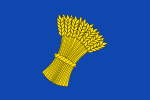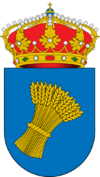Canjáyar facts for kids
Quick facts for kids
Canjáyar, Spain
|
|||
|---|---|---|---|
|
|||
| Country | Spain | ||
| Community | Andalusia | ||
| Municipality | Almería | ||
| Area | |||
| • Total | 67 km2 (26 sq mi) | ||
| Elevation | 618 m (2,028 ft) | ||
| Population
(2018)
|
|||
| • Total | 1,202 | ||
| • Density | 17.94/km2 (46.5/sq mi) | ||
| Time zone | UTC+1 (CET) | ||
| • Summer (DST) | UTC+2 (CEST) | ||
Canjáyar is a small farming town in Almería province, Spain. It is part of the Andalusia region. The town sits by the Andarax river in the Alpujarra area. It is about 47 kilometers from the city of Almería.
Canjáyar has a nice, mild climate. This makes it a good place to visit all year. It is located at the foot of the Sierra Nevada mountains. From there, you can look over to the Sierra de Gádor. The town is surrounded by fruit orchards. These orchards use a system of very old aqueducts for water. Canjáyar is a great spot for enjoying rural tourism.
The town has a special yearly festival. It is called the Holy Cross festival. This event takes place every April 19. It has been celebrated since 1601.
Contents
Town Symbols
Canjáyar has its own flag and coat of arms. Both of these symbols show a golden sheaf of wheat. This wheat is placed on a blue background.
Climate in Canjáyar
Canjáyar has a Mediterranean climate. This means it has hot, dry summers and cool winters. The climate also has some influence from being inland.
Not much rain falls here. The yearly rainfall is usually less than 300 millimeters. Summers are very hot and dry. Temperatures can reach 40 °C. Sometimes, they can even go up to 45 °C.
Winters are cool. Temperatures usually stay between 0 °C and 15 °C. Frosts are rare in the town itself. However, they are more common in the mountains nearby.
Canjáyar's History
Early Times
People lived in this area a very long time ago. Scientists have found remains from the Bronze Age. These were found in a nearby place called Nieles Cave. There is also proof of farming from the Roman times.
Medieval and Modern Eras
The town of Canjáyar was first written about by an Arab geographer. His name was Al-Idrisi. In the 10th century, he mentioned a place called Qansayar. He said it had a defensive fort.
Later, in the 14th and 15th centuries, Canjáyar became very successful. This was because it had good access to water. Farming and raising animals were the main ways people made a living. This continued until lead mining started in the late 1700s.
The town's economy grew a lot in 1835. This happened when table grapes were introduced. New irrigation projects also helped. These projects made more land available for farming.
Around the year 1900, the town's population grew to about 3000 people. This is about twice as many people as live there today. Now, farmers grow many different crops. These include grains, olives, and various fruits.
See also
 In Spanish: Canjáyar para niños
In Spanish: Canjáyar para niños




